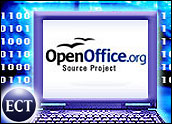
What is free, easy to learn and manage, and compatible with other file formats and every major platform? (Hint: It also represents one less tie to Microsoft.) The answer is OpenOffice.org, according to the creators, managers and evangelists of this open source office productivity suite.
OpenOffice.org is a two-year-old project, the result of more than a dozen volunteers’ efforts to create a software suite that contains a word processor, spreadsheet, presentation program, graphics app and database.
The project has its roots in StarDivision, a German company that originally authored the StarOffice software suite. Microsoft rival Sun Microsystems purchased StarDivision in 1999 and released StarOffice 5.2 in June 2000, while also turning over its code to the OpenOffice.org group of developers. Now, in a turning of the tables, OpenOffice.org’s efforts are at the core of Sun’s most recent StarOffice 6.0 release.
The freely available software is backed by a community of nearly 10,000 users, according to Scott Carr, documentation maintainer for OpenOffice.org. Besides being an inexpensive investment, OpenOffice.org is often a first step for businesses considering a switch to Linux on the desktop.
“With OpenOffice.org, it’s … try before you buy, but you never have to do the ‘buy’ part,” Carr told the E-Commerce Times.
ROI Notable
Some analysts have questioned the merits of an enterprise switch to OpenOffice from Microsoft Office, citing migration costs, training issues, compatibility problems and support worries, but the OpenOffice project leaders insist that choosing the most qualified candidates for a switch can minimize these risks and costs.
“If you go to a site and they have 100 employees, maybe two or three are of the mindset to do some programming,” said Carr. “But the rest of them, they want to go in and have a document that has a couple of fonts … and do a little bit of formatting and be done with it.”
Carr conceded that OpenOffice is not the perfect solution for every desktop user in a company, but added that for the majority, it is a viable option.
Besides usability, the cost savings argument is undeniable, said Sam Hiser, co-leader of marketing for OpenOffice.org. “The ROI that you get from a transition to OpenOffice.org is infinite because you’re going from paying licensing fees that can be grand to [paying] nothing,” he told the E-Commerce Times.
Carr estimated that even taking into account the training costs companies encounter, plus the migration time involved in replacing applications, a business using 1,000 Microsoft Office licenses at US$300 each could save about $300,000 on up-front expenditures by switching to OpenOffice.org.
Format Issues Disputed
But the main selling point for OpenOffice.org is its file and platform compatibility, according to Joerg Heilig, director of engineering for StarOffice at Sun. “XML is the default file format, and we are working on the standardization. It’s documented on OpenOffice.org, and we invite others to work with us,” Heilig told the E-Commerce Times.
Also, because OpenOffice.org can be used on multiple platforms, including Windows, Linux, Solaris and Mac OS X, it is a draw for companies that use more than one platform.
Heilig also disputed claims that OpenOffice.org and StarOffice have difficulties with macros, pivot tables and other items developed in Visual Basic.
“We do support [pivot tables], but we have to call them differently because they are a trademark of Microsoft, so they are called data pilots in StarOffice,” he said. “On the macro side, we do support StarOffice Basic, and we have an extensive basic API so you can do custom solutions based on StarOffice, but the API is different than [Microsoft’s].”
Support a Group Effort
For some companies, turning over support of their most common applications to a community of volunteer IT specialists is a daunting task. However, Carr pointed to rapid turnaround times that range from five minutes to a week for questions posted to the OpenOffice.org mailing list.
Conversely, for calls to Microsoft support, Carr noted, “What is the chance of you actually being able to speak with a developer?”He also lamented that the most common response to a Microsoft support call is the standard refrain, “it’s coming out in the next release.”
Understandably, noted Hiser, some companies require contractual support for their applications. That is one reason OpenOffice.org sees itself as a testing ground for companies considering a StarOffice purchase from Sun, which provides direct support, patches and Q&A testing.
“When you’re talking about a corporation and OpenOffice, you’re really talking about them using OpenOffice to try it out and see how it works,” said Hiser. “That’s an important way in which StarOffice complements OpenOffice, so we tag team.”
Testing Grounds
Sun’s Heilig agreed. “StarOffice is really targeted toward enterprise,” he said. “But we are really based on OpenOffice.org, and our success is based on OpenOffice.org.”
Indeed, for its 6.0 release last April, Sun repackaged the OpenOffice.org core software and included third-party add-ons to give it improved fonts, spell-checking dictionaries and clip art. Sun also added more formalized support.
StarOffice, which sells for an average price of $50 per copy, is flexible and inexpensive enough to be a contender withMicrosoft Office, according to a recent Gartner research note. According to Gartner, StarOffice could gain at least a 10 percent market share at the expense of Microsoft Office by the end of 2004.
But that projected gain was qualified with the note that in order for StarOffice to earn such popularity, Microsoft would have to remain true to its current licensing policies, which took effect July 31st. Companies gained access to continuous Microsoft software upgrades and improved security, but they were required to pay what amounted to costly monthly licensing fees, stirring up frustration with the software giant.
Catalyst for Linux
One of the most compelling reasons to use OpenOffice, according to the project’s supporters, is that it can serve as a testing ground for an eventual switch from Windows to Linux on the desktop.
Once users have migrated to OpenOffice, the reasoning goes, switching to Ximian Evolution, a free e-mail and group calendaring application, and Mozilla, an open source Web browser, becomes easier. And once those transitions are complete, removing Windows entirely and replacing it with Linux becomes less of an issue.
“Many [companies] are thinking of migrating to Linux, and a first step is always to exchange their existing office suite with something that is more open,” said Heilig.
The goal, said OpenOffice.org’s Hiser, is not to put Microsoft out of business, but rather to make free or cheaper software available on a worldwide scale and eventually to increase the size of the overall office productivity software market. Hiser estimated that within 10 years, the market’s size will have increased three to five times — and open source will share a substantial portion of the pie.












































I was initially dissatified with OpenOffice because one feature was supposed to be file format compatibility with MS Office. For heavily formatted documents this was not the case in my brief trial.
That said, I saw a screenshot of the newest version which exports files to .pdf files. I realize it is a matter of piping (in Linux) through ghostscript and to a pdf builder to make pdf files, but native support for this function might make a difference.
There is little reason to add an Access-like database product to OpenOffice, as there are lots of free real full-featured databases available. E.g. Postgresql, SAPdb, Firebird.
And if you need an extremely fast but can do without some advanced features you could go for MySQL.
If you are prepared to use a closed source product and pay some money you could use
Oracle, DB2, Sybase,…
All of these products have better performance, can handle more users, more simultaneous requests, adhere better to standards, and offer better security than MS-Access.
In fact it would be a good idea to switch to one of those database products even if you continue to use MS-Office.
Databases (as those mentioned) can be plugged in to OpenOffice through ODBC or JDBC (and for some purposes also LDAP).
Once plugged in, OpenOffice contains a query designer similar to the one in MS-Access. This makes it very simple to include database information in your documents.
True, OpenOffice doesn’t have GUI tools for building pure database applications like MS-Access. But there are plenty of tools that do this better than MS-Access e.g. Recall from theKompany. (However you could still build such applications in StarBasic that comes with OpenOffice)
Besides most MS-Office users don’t know a normal form when they see one, so design of database applications would probably better be left to professionals in that field. And they are most likely to favor other tools than MS-Access.
And if you really like Access that much you could combine it with OpenOffice as it has ODBC drivers. The best way to do that would probably be to replace the standard Jet engine of Access with the mini version of the SQLServer database engine that comes with Access. That way you can have your database on one machine on the network
and access it through a SQLServer ODBC driver.
By the way, what was wrong with the page preview?
Sorry. I tried my hardest to like Open Office. The page preview alone was enough to make me want to switch back to MS Office. There is no replacement for MS Access and OpenOffice just doesn’t compete.
.
I wasn’t impressed.
.
HighDuck420
The XML feature is the main reason that I’m interested in OpenOffice. Some of the issues I have are (a) the "native" format is really zip that contains XML, and (b) programmer conversion time (minor in my opinion, but still an issue).
You can try out StarOffice 6.0 instantly by clicking on this URL, which is something completely new called an AppLink. You will need Java and Javascript enabled, and your firewall must allow Java applets:
http://www.freedesk.com/APPLINK?ID=4444373D261172BE4730343C201578C63634
You can try out more AppLinks at:
http://applinks.blogspot.com